There are many people didn’t know how to choose the right corrugated box for their product. Today, we will provide a explanation for RSC&HSC these two boxes.
1.The structure and design of RSC and HSC
First of all, let's take a look at the structural designs of the two types of boxes.
(1) Regular Slotted Container
RSC is the most common and economical carton design in the world, with an efficient and standardized structure. Its core feature lies in the cutting method of its flap cover. The main box panel and all the flap covers of the box body are integrally cut and molded from a single piece of corrugated cardboard, with extremely high material utilization and almost no waste.
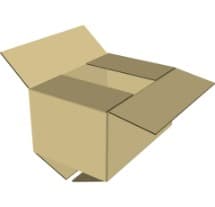
The structure is specifically composed of a single main line bonded together, with inner and outer flaps on both the top and bottom. The length of the inner flaps is usually less than half the width of the box,
while the outer flaps are exactly half the width. When sealing the box, the inner and outer flaps meet at the center line of the box but do not completely overlap, leaving a gap. This design saves material but also means that the central area of the top and bottom of the box is structurally weak, with lower compressive strength. During stacking, the pressure is mainly borne by the four side walls of the box.
(2) Heavy-Duty Corrugated
HSC is not a single box type code but a general term for a category of high-strength cartons, among which the most representative one is the Full Overlap Slot Container (FOL - international box type code 0402). The core objective of its structural design is to maximize the overall strength of the box, especially the compressive and puncture resistance of the top and bottom.
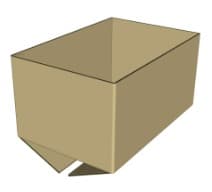
The key difference from RSC lies in the extension length of its flap. The upper and lower outer flaps of HSC are significantly lengthened, with their length equal to the full length of the box (rather than half the width of RSC).
When sealing the box, these extended outer flaps will completely overlap from both sides, covering the entire top and bottom of the box. This means that the top and bottom of the box are reinforced by three layers of corrugated cardboard (one side outer flap + box body + the other side outer flap), forming a solid load-bearing platform.
In summary, the structural design differences between RSC and HSC reflect two distinct design philosophies: RSC aims for maximum economy and efficiency while meeting basic protection requirements, featuring a simple structure and low material consumption, making it suitable for most common scenarios. In contrast, HSC is willing to increase costs and materials to achieve ultimate protection performance, with its fully overlapping structure reinforcing the top and bottom to cope with harsh logistics environments.
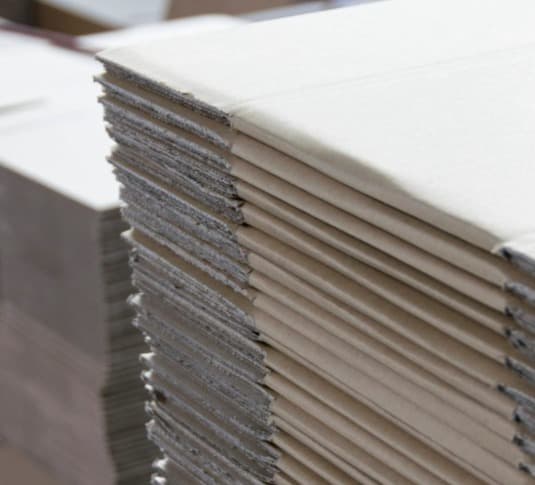
2.Strength and Performance
Next, we will introduce these two types of corrugated boxes in terms of their bursting strength, protection performance and stacking stability.
(1)Bursting Strength
RSC:Its compressive strength mainly depends on the strength of the four side walls of the box and the grade of the used cardboard. Due to the central part of the top and bottom being formed by the lid closing together, there is a structural weakness, and the overall compressive capacity is limited. When subjected to external pressure, the stress is likely to concentrate in the middle of the box, making it more prone to being crushed. It is suitable for goods with a relatively light weight and a low number of stacking layers.
HSC:Its compressive strength has been significantly enhanced. The key lies in its fully covered design, which secures the top and bottom of the box with three layers of cardboard, forming a sturdy load-bearing platform. This greatly improves the overall compressive strength of the box, enabling it to withstand the powerful forces of heavy internal objects and external high pressure, and preventing deformation or collapse.
(2)Protection performance
RSC: It provides basic protection, effectively preventing minor bumps and dust during transportation. However, its relatively thin top and bottom of the box have weak puncture resistance, and are insufficient in buffering sharp or heavy internal items as well as external impacts. It is suitable for packaging sturdy items that are not fragile and do not require compression.
HSC: It can provide outstanding all-round protection. The thickened box walls and the three-layer reinforced top and bottom provide excellent anti-penetration and impact resistance. This structure can better absorb and disperse external forces, significantly reducing the risk of damage to internal valuable, fragile or precision items during rough transportation and high-level stacking pressure. It is the preferred choice for heavy, high-value, and fragile items.
(3) Stacking Stability
RSC: The stacking stability is generally poor. During stacking, the entire weight of the upper box is mainly transmitted through its four bottom corners to the four corners of the bottom box above. The pressure distribution is uneven. When stored for a long time or when the stacking height is too high, the lower box may deform due to fatigue, posing a risk of collapse.
HSC: The stacking stability is excellent. The fully covered design creates a large area of continuous contact between the upper and lower layers of boxes, rather than just point or line contact. This design evenly distributes the stacking pressure across the entire surface of the box, significantly improving the stability and safety of the stacking, and is highly suitable for scenarios requiring long-term high-level storage.
To sum up, the choice between RSC and HSC is a trade-off between cost and performance. RSC offers an economical solution for lightweight, standard cargo but has inherent weaknesses in stacking strength, protection, and stability. In contrast, HSC, with its full-overlap design, provides superior performance in these areas, ensuring reliable protection for heavy, high-value goods in demanding logistics environments. Its higher cost is a necessary investment for maximum security. The decision should be based on product characteristics and logistical risks.
3.Cost and Materials
The amount and cost of paper used for different boxes may vary.
(1) Paper usage
RSC: Due to its structural characteristics, the RSC, when unfolded, includes a complete set of four side panels and symmetrical upper and lower covers. The covers need to cover the entire surface of the box top and bottom to achieve sealing. The unfolded area of the paper is relatively large. Taking a common rectangular box as an example, the length of its cover is usually half of the box depth. When the side panels and the connecting parts are stacked together, the overall paper consumption is higher than that of the HSC of the same specification.
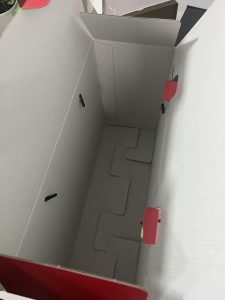
HSC: Only one side has a complete lid, while the other side is mostly open or has a simple folding structure, which reduces the paper usage for the lid part. Under the same internal dimensions, the paper consumption of HSC is usually 10%-15% less than that of RSC.
(2) cost of production
In terms of raw material costs, RSC has a higher single-box raw material cost than HSC due to its greater paper usage, by approximately 8% to 12%. In terms of processing costs, slitting of RSC and indentation processes are more complex, especially the symmetrical cutting of the upper and lower lids, which may increase equipment debugging time and scrap rate.
While HSC has a simpler structure and a shorter processing flow, with production efficiency about 15% higher than RSC, indirectly reducing the unit-hour cost. Overall, the production cost of HSC for the same specification is 10% to 20% lower than that of RSC.
(3) Corrugated combination
As general transportation packaging, RSC demands high structural strength, commonly using three-layer C corrugation or five-layer BC corrugation. C corrugation, with appropriate height, offers good buffering and rigidity for most daily necessities. Five-layer BC corrugation combines pressure-resistant B corrugation and buffering C corrugation, suiting heavy products or long-distance transportation.
HSC, for lightweight products or inner boxes with lower strength needs, uses three-layer B or E corrugation. B corrugation has small pitch and smooth surface, ideal for printing and stacking lightweight items. Thinner, lighter E corrugation fits fine packaging of small, low-weight products, saving storage space.
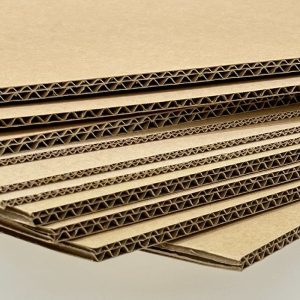
The core characteristics of RSC and HSC differ significantly. RSC consumes more paper and incurs higher production costs, but its three-layer or five-layer strong corrugated structure ensures superior strength and sealing, ideal for general transportation. In contrast, HSC excels in lower paper usage and costs, with lightweight corrugated materials suiting lightweight products or simple packaging. Selecting the right type optimizes overall packaging efficiency.
4.application scenarios
(1) Common uses
RSC: Used for packaging of e-commerce parcels, consumer goods (clothing, books, etc.) and small components of lightweight products.
HSC: For heavy and high-value products such as automotive components, industrial equipment, and large household appliances, materials like glass-ceramics and heavy machinery parts are also commonly used.
(2) logistics environment
RSC offers standard express delivery, land transportation, and short-term storage services. The process is relatively simple and the turnover is fast.
HSC is capable of withstanding long-distance transportation, cross-border maritime shipping, and the demanding long-term environments requiring high-level stacking, and is highly durable.
(3) Customer impression
RSC, with its design centered around meeting the demands of general - purpose logistics, offers a standard, universal, and cost - effective feel. As a typical choice for regular logistics packaging, it is widely applied in numerous common scenarios. It is frequently used for packaging e - commerce parcels, consumer goods like clothing and books, as well as small - sized components. These are all lightweight products that don't require extremely high - end or specialized packaging protection. In terms of the logistics environment, RSC is well - suited for standard express delivery, land transportation, and short - term warehousing.
HSC embodies solid professionalism, honed through deep industry expertise in addressing the unique challenges of packaging valuable and heavy items—from mastering load distribution dynamics to selecting materials that balance strength and adaptability. Its high-end quality is evident in premium material sourcing and strict manufacturing standards, ensuring each component meets rigorous benchmarks for durability and resilience.
RSC is suitable for lightweight daily products and provides standard economic services for regular logistics; HSC focuses on heavy and high-value products and is designed to withstand rigorous transportation with its sturdy and reliable features. By choosing either one based on the scenario, you can precisely meet packaging requirements and optimize logistics value.
5.How to choose between these two types of boxes
When choosing a packaging solution, compare RSC (0201) and HSC (0402) based on different characteristics:
- In terms of cost, RSC is lower and more advantageous.
- For strength, HSC is extremely high and performs better.
- Regarding material efficiency, RSC is higher and has an edge.
- In terms of universality, RSC is extremely high and more widely applicable.
- For protection of heavy items, HSC is excellent and better ensures safety.
- In terms of stacking stability, HSC is superior and more reliable for stacking.
Overall, RSC wins in cost, material efficiency, and universality; while HSC is better in strength, protection for heavy items, and stacking stability. Choose RSC if you focus on cost and universality; choose HSC if you value strength and protection for heavy items.
Hope from this explanation you can make a right choose between RSC and HSC! If you have any needs welcome to contact us!
Post time: Aug-27-2025



